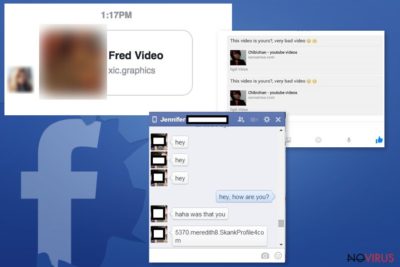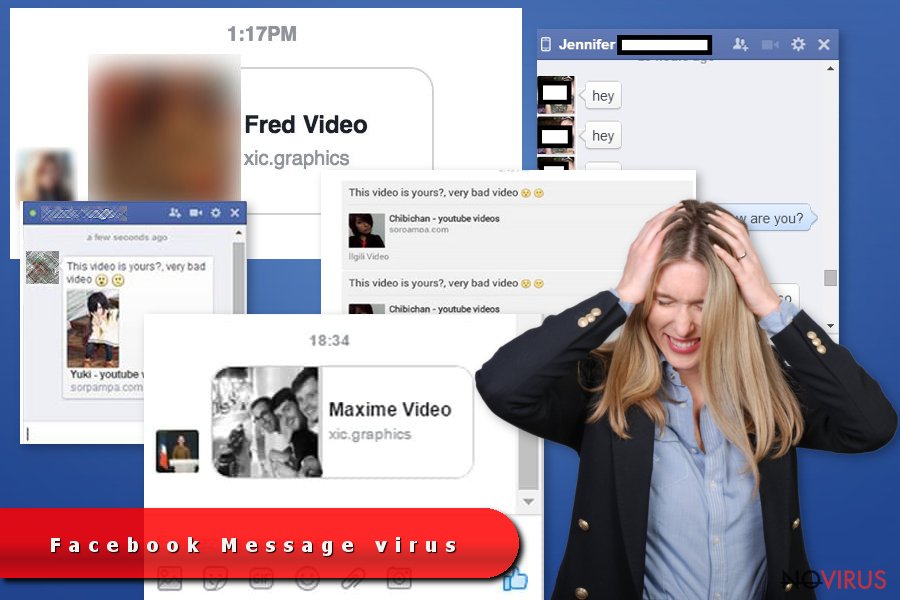Uninstall Facebook Message virus (Uninstall Instructions) - Aug 2017 updated
Facebook Message virus Removal Guide
Description of Facebook Message virus
Facebook Message virus starts its journey

Facebook Message virus happens to be the latest version of the Facebook virus. Like its predecessor which struck the Facebook community last year, it targets victims with the counterfeited video link and message ‘[person’s name] video emoji.’ The infection is distributed via Facebook Messenger as well.
Once a targeted victim activates the link, they will be redirected to another site which either suggests installing a dubious media player or a fake Flash Player update. Nonetheless, the problems do not end here. All contacts of the person, who opened the link, will get an identical message only with their profile picture on it. Interestingly, this time, scammers have elaborated the malware and devised multiple scenarios.
If you open the link via Chrome browser, you will be misled to a forged YouTube page which asks you to enable a dubious un-rated browser extension. Note that it might bear the same title as a legitimate program available on the Chrome web store. Firefox and Safari users will be misguided to a fake Flash Player page which offers to install a dubious Media Player.
If you risk to install it, DealPly adware will be downloaded to the device. Surprisingly, you can find the application on its official site. Despite that, its security flaws and privacy policy resulted in IT experts labeling it as adware. Besides coupons and commercial deals, the ads and redirections to shady domains will plague your browsing sessions.
Campaign emerges with a new flare
Though the original version Facebook message malware has already emerged in 2013, it is aggravating how many Facebook netizens fall for the bait twice or even thrice. While the virus exploits the same bait users’ profile picture, it is intriguing that the malware leads to numerous scenarios.
While this time, the campaign joins forces with adware, it is possible to assume that sooner or later developers will shift to more menacing malware. The success rate of other “Facebook” scams, including the Jayden K. Smith and free flight ticket give away, imply that such campaign might be successful as well.
In 2016, users were terrorized with another version of Facebook Messenger trojan named “Eko”. It was programmed to collect personal data and transmit it to remote servers. Another video virus campaign followed it. At that time, the perpetrators tried to trigger users’ curiosity with such remarks as: ‘You are in this video?’ or ‘This is your video?’ 
Last year’s Locky campaign is also worth mentioning. It managed to infiltrate the social network and spread the image file in the SVG format. After clicking on the file, then users were redirected to another page asking to enable a shade Chrome extension. Unfortunately, enabling it would accelerate further Locky hijack.
It might be highly erroneous to underestimate this infection as the past versions of the malware reveal that felons are not only interested in infecting users with exquisite virtual threats and extort money but steal personal information as well.
If you have already encountered this virtual misfortune, it is high time for you to remove Facebook Message virus. For that purpose, FortectIntego or Malwarebytes might be of service.
August 25th, 2017 (update): the malware now uses Google Docs link
The very video message includes a bit.ly link which directs you to either of the above-mentioned destinations. However, some samples of the virus even misguides users to Google Doc link. After you get redirected through multiple URL addresses and finally and on the final page, you will see a video with your profile picture.
Tempted to watch the video, users might install the promoted media player only to find out adware and malware on their devices later on. As mentioned before, the malware will also plague your Facebook account and send out the malicious link to your friends.
Facebook community speeds up the malware traffic
IT experts still speculate where is the initial source of infection. Since credulous users click on the link and, likewise, pass the infection to their friends, it is likely that the penetrators compromised an account to spread the link among certain members of Facebook.
It might be a mistake to disregard the possibility that the initial stage of the malware began in another domain,. i.e. someone activated malware by opening a malicious script in a gaming or movie streaming sites.
Thus, in order to get lower the probability of the infection, make sure you double-check the sender’s identity before opening their sent links. Having an anti-spyware tool covering your PC back is also beneficial. Now let us discuss Facebook Message virus removal options.
Eliminate Facebook Message virus from the PC and restore access to the account
Even if you received the suspicious link which seems to be the very virus but have not clicked on it yet, scan the device with malware elimination software. You may also clear the browsing data or even reset the browser settings.
In case you opened the video link, here are the following steps:
- Scan the system with a cyber security tool to remove Facebook Message virus
- Reset the browser settings
- Complete the account recovery steps suggested by Facebook
- In case, the latter step cannot be finished, contact Facebook Help Center
- Change your account password
It is highly recommended to scan the device multiple times to ensure Facebook Message virus removal is complete. As for the password tips, make up an elaborated pass code which is comprised of, at least, 12 characters, including numbers, diacritical marks, and symbols. Use incorrect forms of words.
How to prevent from getting malware
A proper web browser and VPN tool can guarantee better safety
As online spying becomes an increasing problem, people are becoming more interested in how to protect their privacy. One way to increase your online security is to choose the most secure and private web browser. But if you want complete anonymity and security when surfing the web, you need Private Internet Access VPN service. This tool successfully reroutes traffic across different servers, so your IP address and location remain protected. It is also important that this tool is based on a strict no-log policy, so no data is collected and cannot be leaked or made available to first or third parties. If you want to feel safe on the internet, a combination of a secure web browser and a Private Internet Access VPN will help you.
Reduce the threat of viruses by backing up your data
Due to their own careless behavior, computer users can suffer various losses caused by cyber infections. Viruses can affect the functionality of the software or directly corrupt data on your system by encrypting it. These problems can disrupt the system and cause you to lose personal data permanently. There is no such threat if you have the latest backups, as you can easily recover lost data and get back to work.
It is recommended to update the backups in parallel each time the system is modified. This way, you will be able to access the latest saved data after an unexpected virus attack or system failure. By having the latest copies of important documents and projects, you will avoid serious inconveniences. File backups are especially useful if malware attacks your system unexpectedly. We recommend using the Data Recovery Pro program to restore the system.
